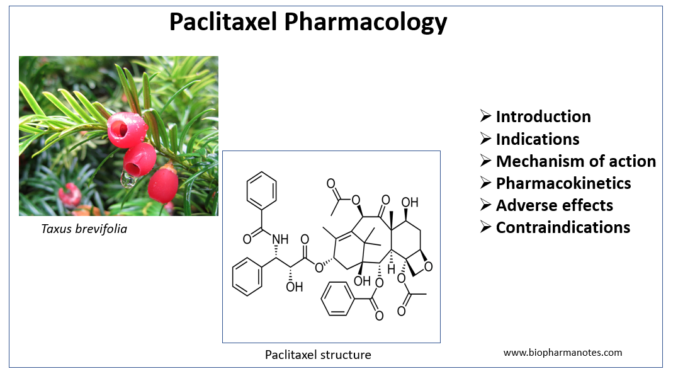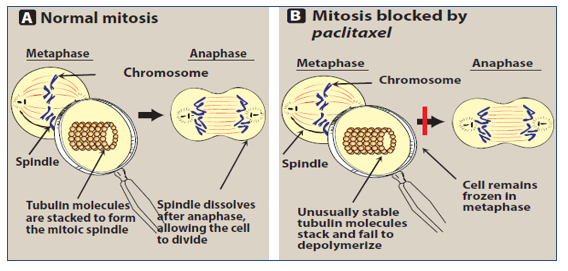
- Paclitaxel is natural product with antitumor activity. It is isolated from bark of Western Yew tree (Taxus brevifolia). Paclitaxel is microtubule inhibitor.
- It is first member of taxane family to be used for treatment of cancer. Its derivative docetaxel is also available which have a substitution in sidechain. It is more potent than paclitaxel.
Indications of Paclitaxel
- Used to treat breast and ovarian cancer.
- It is used in treatment of lung, head, neck, bladder and esophageal cancer.
Mechanism of action of paclitaxel

Figure- Mechanism of action of Paclitaxel (Source- Lippincott’s Illustrated Reviews)
- It binds to beta-subunit of tubulin and form stable, non-functioning microtubule. Due to non-functional microtubule, chromosomal desegregation doesn’t occur. Hence, it inhibits mitosis resulting in death of cells. The binding site is different than of vinca alkaloids and colchicine derivatives.
- The cells are affected in G2/M phase of cell cycle.
Pharmacokinetics of paclitaxel
- It has high molecular weight and has very less solubility in water. Due to low solubility, it is generally administered in a vehicle Cremophor EL consisting of 50% ethanol and 50% polyethoxylated castor oil. This combination of vehicle has chances of causing hypersensitivity reactions. The chances of hypersensitivity can be minimized by pretreating patients with histamine antagonist like cimetidine and diphenhydramine or glucocorticoids like dexamethasone. Recently, a nanoparticle albumin bound form of paclitaxel is introduced which doesn’t cause hypersensitivity reaction.
- It is administered as IV solution. It is metabolized by CYP450 system. Distribution is rapid and binding with plasma protein is significant (90%). It is excreted via biliary route in the form of feces. Dose adjustment is necessary in patients with hepatic problem but nor in renal dysfunction.
- Efficacy and toxicity may depend on combination with other antineoplastic agents and also sequence of chemotherapy administration.
Adverse effects
- The common side effects include hypersensitivity reactions, leukopenia, neutropenia, peripheral sensory neuropathy and alopecia. Neuropathy symptoms are reversible. However, in some patients the symptom may remain even after 2 years of cessation of drug.
- Other side effects include asymptomatic bradycardia or episodes of silent ventricular tachycardia, myalgia, diarrhea, increased level of serum alkaline phosphatase and increased level of serum aspartate aminotransferase.
Contraindication and warning
- It should not be reused in patients who showed severe hypersensitivity reaction in first use.
- It should not be used in patients with low baseline neutrophil count (less than 1500 cells/mm3).
- Contraindicated in pregnancy and breastfeeding mothers.
References
- Weger de, Vincent A, Beijnen, Jos H, Jan HM. Cellular and clinical pharmacology of the taxanes docetaxel and paclitaxel – a review. Anti-Cancer Drugs. 2014; 25(5): 488-494.
- Tore B, Troels KB, Deanna LK. Clinical Pharmacokinetics of Paclitaxel Monotherapy: An Updated Literature Review. Clin Pharmacokinet. 2018; 57: 7-19.
- Pharmacology and Pharmacotherapeutics. 24th edition.
- Goodman and Gillman Manual of Pharmacology and Therapeutics.
- Lippincott Illustrated Reviews Pharmacology, 6th edition.
- https://www.ncbi.nlm.nih.gov/books/NBK536917/